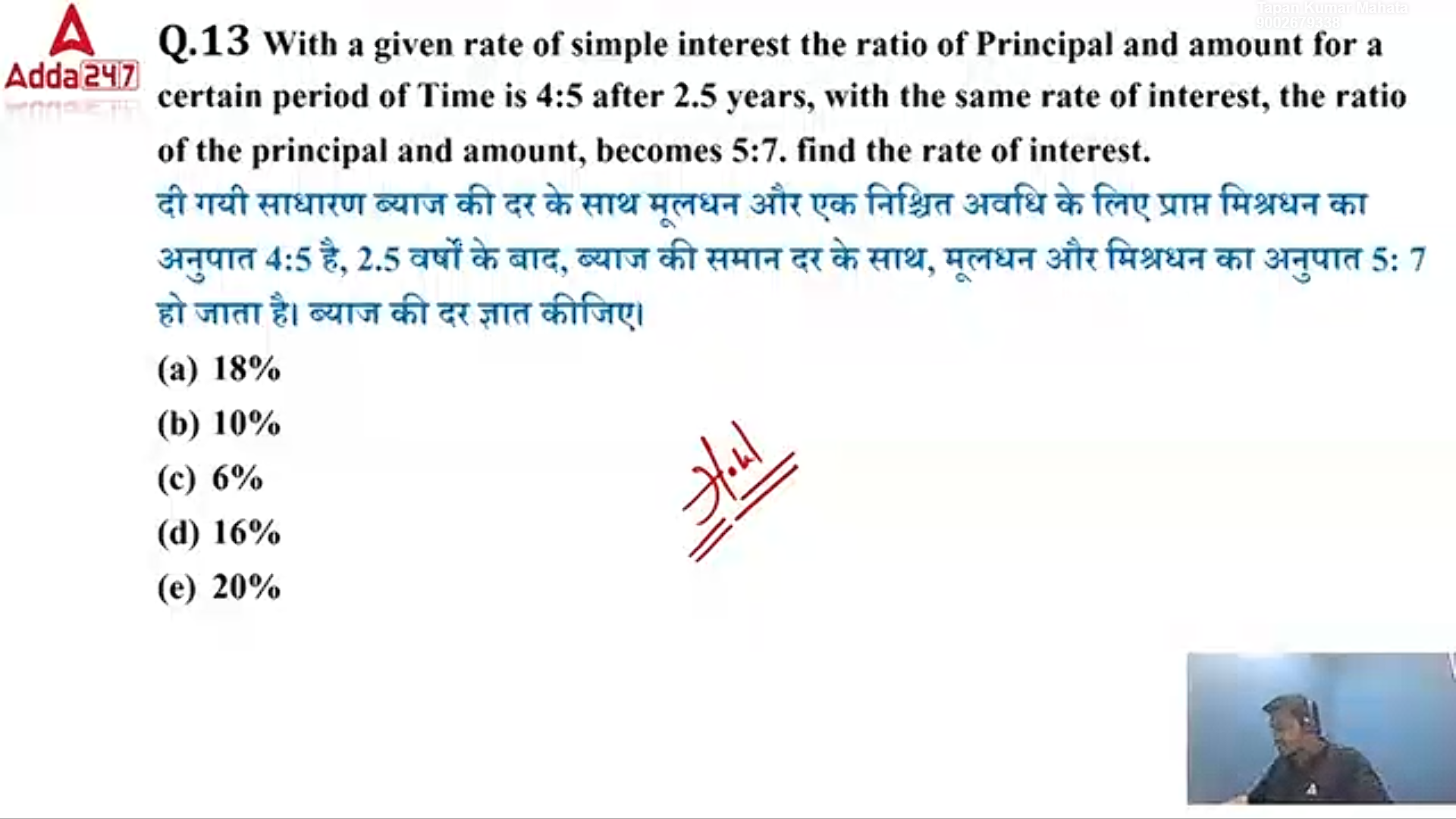With a given rate of simple interest, the ratio of Principal and amount for a certain period of time is 4:5 after 2.5 years. With the same rate of interest, the ratio of principal... With a given rate of simple interest, the ratio of Principal and amount for a certain period of time is 4:5 after 2.5 years. With the same rate of interest, the ratio of principal and amount becomes 5:7. Find the rate of interest.

Understand the Problem
The question is asking to find the rate of interest given a ratio of principal to amount after a certain time period. The initial ratio is 4:5 and after 2.5 years, this changes to 5:7. We need to determine the rate of interest from this information.
Answer
The rate of interest is $6\%$.
Answer for screen readers
The rate of interest is $6%$.
Steps to Solve
- Establish Initial Ratios
The initial ratio of Principal (P) to Amount (A) after 2.5 years is given as 4:5.
Let's express this:
$$
\frac{P}{A} = \frac{4}{5}
$$
From this, we know that:
$$
A = P + SI
$$
where $SI$ is the Simple Interest.
- Define Relationships with Simple Interest
From the initial ratio, we can express the amount in terms of the principal: $$ A = \frac{5}{4} P $$ This implies: $$ SI = A - P = \frac{5}{4}P - P = \frac{1}{4}P $$
- Using the Equation for A New Time Period
After another time period, the ratio changes to 5:7. For the new ratio: $$ \frac{P}{A'} = \frac{5}{7} $$ We can express this similar to the previous step: $$ A' = \frac{7}{5}P $$ And the new Simple Interest ($SI'$) based on the new amount becomes: $$ SI' = A' - P = \frac{7}{5}P - P = \frac{2}{5}P $$
- Calculate the Time Period and Interest Rate
The time difference is 2.5 years. So, the interest earned during this period can be expressed as: $$ SI' - SI = \frac{2}{5}P - \frac{1}{4}P $$ To simplify this, find a common denominator: $$ = \frac{8}{20}P - \frac{5}{20}P = \frac{3}{20}P $$ This amount corresponds to the interest accumulated over 2.5 years.
- Calculate Rate of Interest
Now that we have the total interest for the 2.5 years, we use the formula for Simple Interest: $$ SI = \frac{P \times R \times T}{100} $$ Where:
- $R$ is the rate of interest,
- $T$ is the time in years (2.5 years).
Substituting the values we obtain: $$ \frac{3}{20}P = \frac{P \times R \times 2.5}{100} $$ Cancelling out $P$ from both sides: $$ \frac{3}{20} = \frac{R \times 2.5}{100} $$
Multiplying both sides by 100: $$ 15 = R \times 2.5 $$ Finally, divide both sides by 2.5 to find $R$: $$ R = \frac{15}{2.5} = 6% $$
The rate of interest is $6%$.
More Information
This problem uses the principles of ratios and simple interest calculations. It illustrates how to derive unknown variables using given ratios, leading to a straightforward calculation of interest rates.
Tips
- Confusing the difference between amounts calculated at different time periods can lead to errors in determining the correct ratios.
- Not simplifying expressions properly before solving for the rate of interest can complicate the calculations unnecessarily.
AI-generated content may contain errors. Please verify critical information